ALL EXTRA CREDIT Qs
1/91
There's no tags or description
Looks like no tags are added yet.
Name | Mastery | Learn | Test | Matching | Spaced |
|---|
No study sessions yet.
92 Terms
Which two staining techniques employ a mordant?
Gram stain and acid-fast stain
Gram stain and capsule stain
Simple stain and acid-fast stain
Capsule stain and flagella stain
Gram stain and flagella stain
5
Which of the following uses glucose for carbon and energy?
chemoautotroph
chemoheterotroph
photoautotroph
photoheterotroph
2
Which of the following statements about gram-negative cell walls is FALSE?
They are sensitive to penicillin.
They are toxic to humans.
They have an extra outer layer composed of lipoproteins, lipopolysaccharides, and phospholipids.
They protect the cell in a hypotonic environment.
Their Gram reaction is due to the outer membrane.
1
In non-cyclic photophosphorylation, excited electrons ultimately ________.
combine with hydrogen ions and NADP+ to produce NADPH
flow through ATP synthase
generate light within the spectrum of green wavelengths
are used to form water
return to chlorophyll
1
The functions of the glycocalyx in bacteria include all of the following except:
Biofilm formation
Binary fission
Increased virulence
Protection against dehydration
Source of nutrition
2
Which of the following pairs is mismatched?
safranin – acid dye
carbolfuchsin – basic dye
alcohol-acetone - decolorizer
iodine – mordant
crystal violet – basic dye
1

In the figure, where is ATP produced?
a
b
c
d
e
5
Which of the following structures is not a functionally analogous pair?
Chloroplasts — thylakoids
9+2 flagella — bacterial flagella
Cilia — pili
Mitochondria — prokaryotic plasma membrane
Nucleus — nucleoid region
3
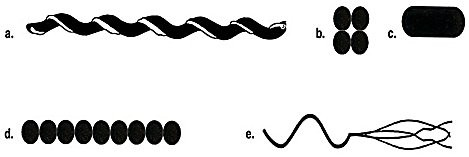
Which drawing in the figure is streptococci?
a
b
c
d
e
4
Cyanobacteria are a type of
chemoautotroph.
chemoheterotroph.
photoautotroph.
photoheterotroph.
3
Which of the following statements is incorrect about prokaryotic cells?
They typically have a circular chromosome.
They reproduce by binary fission.
They lack membrane-enclosed organelles.
They lack a plasma membrane.
Their DNA is not enclosed within a membrane.
4

Which of the graphs in the figure best illustrates the activity of an enzyme that is saturated with substrate?
a
b
c
d
e
3
Which of the following statements regarding metabolism is not possible?
Anabolic reactions are degradative.
Heat may be released in both anabolic and catabolic reactions.
ATP is formed in catabolic reactions.
ADP is formed in anabolic reactions.
1
Microorganisms that catabolize sugars into ethanol and CO2 gas would most likely be categorized as ________.
anaerobic respirers
alcohol fermenters
aerobic respirers
heterolactic fermenters
homolactic fermenters
2
A ________ can be used to view the internal structures of cells in its native state?
fluorescence microscope
phase-contrast microscope
electron microscope
compound light microscope
scanning acoustic microscope
2
________ allows a cell transport of substances from a lower to a higher concentration area.
Simple diffusion
Active transport
Facilitated diffusion
Extracellular enzymes
Aquaporins
2
Which of the following is NOT found or observed to occur in both mitochondria and prokaryotes?
cell wall
ATP-generating mechanism
70S ribosomes
binary fission
circular chromosome
1
Which microscope takes advantage of differences in the refractive indexes of cell structures?
darkfield microscope
phase-contrast microscope
electron microscope
fluorescence microscope
compound light microscope
2
A virus measures 100 nm in length. What is its length in μm?
1 μm
10 μm
0.1 μm
0.01 μm
0.001 μm
3
An enzyme, citrate synthase, in the Krebs cycle is inhibited by ATP. This is an example of all the following except:
Feedback inhibition
Allosteric inhibition
Noncompetitive inhibition
Competitive inhibition
4
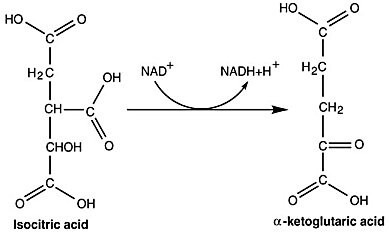
Which compound is being reduced in the reaction shown in the figure?
NADH
isocitric acid and α-ketoglutaric acid
α-ketoglutaric acid and NAD+
NADH and isocitric acid
NAD+
5
Which statements correspond to amphibolic pathways?
1. Anabolic and catabolic reactions are joined through common intermediate.
2. They are shared metabolic pathways.
3. Feedback inhibition can help regulate rates of reactions.
4. Both types of reactions are necessary but do not occur simultaneously.
2, 3, 4
2, 4
1, 2, 3, 4
1, 2, 3
1 only
4
Which of the following statements about anaerobic cellular respiration is not true?
It yields lower amounts of ATP when compared to aerobic respiration.
The complete Krebs cycle is utilized.
It generates ATP.
It involves the reduction of an organic final electron acceptor.
It requires cytochromes.
4
Which of the following is the best definition of oxidative phosphorylation?
ATP is directly transferred from a substrate to ADP.
Electrons are passed through a series of carriers to O2.
A proton gradient allows hydrogen ions to flow back into the cells through transmembrane protein channels, releasing energy that is used to generate ATP.
Electrons are passed through a series of carriers to an organic compound.
3
The application of phage typing is based on the fact that ________.
bacterial viruses attack only members of a specific species
bacteria are destroyed by viruses
viruses cause disease
Staphylococcus causes infections
phages and bacteria are related
1
Which of the following arthropods does NOT transmit diseases by sucking blood from a human host?
fleas
houseflies
kissing bugs
mosquitoes
lice
2
Which of the following is NOT utilized to culture viruses?
embryonated eggs
animal cell cultures
bacterial cultures
culture media
laboratory animals
4
Which of the following pairs are mismatched?
Cytophaga — a gliding, nonfruiting bacterium
Archaea — extremophiles
Dissimilatory sulfate-reducing bacteria — produce H2S
Actinomycetes — reproduce by fragmentation
Chemoautotrophic bacteria — fix atmospheric nitrogen
5
Which of the following is necessary for replication of a prion?
lysozyme
DNA polymerase
RNA
DNA
PrPSc
5
Bacteriophages and animal viruses do not differ significantly in which one of the following processes?
Release
Attachment
Uncoating
Penetration
Biosynthesis
5
Into which group would you place a photosynthetic cell that lacks a nucleus?
Plantae
Protista
Bacteria
Animalia
Fungi
3
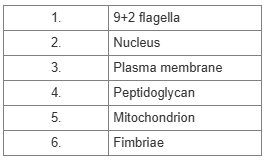
In the table, which features are found in nearly all members of the Domain Eukarya?
3, 5
1, 2, 5
1, 4, 6
2, 3, 5
2, 3
4
Which of the following statements regarding lichens is FALSE?
Lichens are often the first life form to colonize rock or soil.
Lichens are a mutualistic relationship between a fungus and a protozoan.
The algal partner produces carbohydrates that are absorbed by the fungal partner.
Lichens represent a mutualistic relationship between a fungus and an alga.
The fungal partner provides a means of attachment and protects the algal partner from desiccation.
2
Which of the following best describes the bacterial group found primarily in the intestines of humans?
Endospore-forming rods
Gram-negative aerobic rods and cocci
Aerobic, helical bacteria
Gram-positive cocci
Facultatively anaerobic gram-negative rods
5

This figure shows the results of a gel electrophoresis separation of restriction fragments of the DNA of different organisms.
In the figure, which two organisms are most closely related?
1 and 3
2 and 4
2 and 5
3 and 5
4 and 5
1
A feature that may be found in viruses but never in bacteria is
may contain an RNA genome.
an ability to infect more than one type of host.
a sensitivity to antibiotics.
the ability to pass through 0.22 micrometer pore filters.
they cannot reproduce themselves outside a host.
1
In a direct ELISA test for COVID-19, the method is determining if ________ is/are present in the patient's sample by attempting to bind a labeled antibody to it.
a bacteriophage that can infect a particular bacterial strain
antibodies against SARS-CoV-2 found in a patient's blood
SARS-CoV-2 or an antigen from the virus
a known sequence of DNA from a pathogen
3
Staphylococcus and Streptococcus can usually be differentiated by microscopic examination because of their ________.
cell shape
acid-fast reaction
Gram stain reaction
cell arrangement
endospore formation
4
The genus of bacteria that are particularly problematic in hospital settings due to their ability to grow in solutions with minute traces of unusual carbon sources is
Campylobacter.
Pseudomonas.
Legionella.
Staphylococcus.
Vibrio.
2
A definitive host harbors which stage of a parasitic cycle?
Cyst
Larva
Miracidium
Adult
All of the answers are correct.
4
What is not true regarding viruses that infect plants?
They must enter through a wound or be introduced by an insect feeding.
They can sometimes be cultured in insect cells.
They are often cultured in embryonated chicken eggs.
They are morphologically similar to animal viruses.
They can spread via pollination.
3
If a larva of Echinococcus granulosus is found in humans, humans are the
infected host.
reservoir.
intermediate host.
definitive host.
None of the answers is correct.
3
The most conclusive evidence that viruses cause cancers was provided by
finding oncogenes in viruses.
the presence of antibodies against viruses in cancer patients.
some liver cancer patients having had hepatitis.
treating cancer with antibodies.
cancer that developed in chickens following injection of cell-free filtrates.
5
Which of the following is NOT a characteristic of spirochetes?
easily observed with brightfield microscopy
found in the human oral cavity
gram-negative
possess an axial filament
helical shape
1
You have isolated an aerobic gram-positive, endospore-forming bacterium that grows well on nutrient agar. To which of the following groups does it most likely belong?
deltaproteobacteria
bacillales
phototrophic bacteria
gammaproteobacteria
The answer cannot be determined based on the information provided.
2
Actinomycetes differ from fungi in that actinomycetes
are chemoheterotrophs.
cause disease.
lack a membrane-bounded nucleus.
are decomposers.
require light.
3
Assume you have isolated a multicellular heterotrophic organism that produces coenocytic hyphae, motile zoospores, and cellulose cell walls. It is most likely a(n)
oomycote alga.
zygomycete fungus.
ascomycete fungus.
tapeworm.
green alga.
1
Which of the following statements about members of the Kingdom Plantae is false?
They use organic carbon sources for their metabolism.
They are composed of eukaryotic cells.
They are multicellular.
They are photosynthetic.
They synthesize organic molecules.
1
Fatty acid methyl ester analysis is commonly used in ________.
bacterial identification
DNA sequencing reactions
DNA fingerprinting
serological identification methods
1
What contributes to antigenic shift in influenza viruses?
attachment spikes
ease of virus transmission
a segmented genome
different virus subtypes
worldwide distribution of the virus
3
The mechanism whereby an enveloped virus leaves a host cell is called
penetration.
transduction.
abduction.
lysogeny.
budding.
5
Which of the following pairs is mismatched?
Basidiomycota – basidiospores
Zygomycota – sporangiospores
microsporidia – lack mitochondria
anamorphs – lack spores
Ascomycota – conidiospores
4
Which of the following is the most effective control for malaria?
eliminate the intermediate host
vaccination
eliminate Anopheles mosquitoes
treating patients
None of these is an effective control.
3
A bacterial species differs from a species of eukaryotic organisms in that a bacterial species
does not breed with other species.
is a population of cells with similar characteristics.
breeds with its own species.
has a limited geographical distribution.
can be distinguished from other bacterial species.
2
You observe a mass of amoeba-like cells that swarm together, form a stalk, and produce spores. This is a(n)
ascomycete.
plasmodial slime mold.
Euglenozoa.
tapeworm.
cellular slime mold.
5
Aerotolerant anaerobes:
Tolerate normal atmospheric nitrogen gas levels.
Are killed by oxygen.
Do not use oxygen but can tolerate it.
Require more oxygen than is present in air.
Require less oxygen than is present in air.
3
According to the operon model, for the synthesis of an inducible gene to occur, the ________.
substrate must bind to the enzyme
end-product must not be in excess
protein repressor must not be synthesized
substrate must bind to the protein repressor
protein repressor must bind to the operator
4
All of the following methods are effective for destroying prions except:
Proteases
Incineration
Boiling
NaOH + autoclaving at 134°C
None of the answers are correct; each of these will destroy prions
3
Which of the following is NOT a product of transcription?
rRNA
a new strand of DNA
tRNA
mRNA
2
The biosafety level (BSL) for most introductory microbiology laboratories is
BSL-1.
BSL-2.
BSL-3.
BSL-4.
1
An advantage of cDNA over genomic DNA is that it ________.
does not contain exons
is easy to isolate
can form very large DNA fragment
contains selectable markers
does not contain introns
5
A gene is ________.
any random segment of DNA
the RNA product of a transcribed section of DNA
a three-nucleotide segment of DNA that code for an amino acid
a sequence of nucleotides in DNA that codes for a functional product
a sequence of nucleotides in RNA that codes for a functional product
4
Often, patients with indwelling catheters (long-term tubes inserted into body orifices for drainage, such as through the urethra and into the urinary bladder) are susceptible to infections because:
Injected solutions are contaminated.
Their immune systems are weakened.
Bacteria cause infections.
Infections can be transmitted from other people.
Biofilms develop on catheters.
5
If cells are grown in media containing amino acids labeled with radioactive nitrogen (15N), most of the radioactivity will be found in the cells'
DNA.
DNA and phospholipids.
proteins.
DNA and proteins.
phospholipids.
4
Which of the following is NOT a desired characteristic of DNA vectors used in gene cloning procedures?
may replicate in several species
circular form of DNA or integrates into the host chromosome
has a selectable marker
large size
self-replication
4
A sample of milk is tested for its bacterial content in a plate count assay. A 1 ml sample of the milk is diluted in a 1:10 serial dilutions. 1ml of the third dilution tube is plated in a pour plate. After incubation, the plate has 54 colonies, indicating that the original milk sample contained ________ cells per milliliter.
54
5,400
540
540,000
54,000
5
If you were preparing nutrient agar at home and did not have an autoclave, what could you use to sterilize the nutrient agar?
pressure cooker at 121°C for 15 minutes
bleach
hydrogen peroxide
boiling for one hour
oven at 121°C for one hour
1
Which enzyme catalyzes the biochemical reaction: 2H2O2 → 2H2O + O2?
Catalase
Oxidase
Peroxidase
Superoxide dismutase
1
Culture 1: F+, leucine+, histidine+
Culture 2: F-, leucine-, histidine-
In the table, if culture 1 mutates to Hfr, what will be the result of conjugation between the two cultures?
1 will become F+, leu+, his+; 2 will become F+, leu+, his+
They will both remain the same.
1 will remain the same; recombination may occur in 2
1 will become F-, leu+, his+; 2 will become Hfr, leu+, his+
The answer cannot be determined based on the information provided.
3
Which of the following statements best describes the pattern of microbial death?
The pattern varies depending on the antimicrobial agent.
The cells in a population die at a constant rate.
All the cells in a culture die at once.
Not all of the cells in a culture are killed.
The pattern varies depending on the species.
2
Most fungi grow best at pH
5.
14.
9.
7.
1.
1
An experiment began with 4 bacterial cells in log phase and ended with 128 cells. How many times the cells divided?
32
64
6
4
5
5
The fact that people continue to be concerned about the safety of DNA technology can be attributed to which of the following?
Both that it is impossible to prove something is safe under all conditions and that science can only provide supporting evidence for hypotheses.
Science can definitively disprove hypotheses but can only provide supporting evidence for hypotheses.
There is mounting scientific evidence that DNA technology is unsafe.
People are suspicious of science, in general.
It is impossible to prove something is safe under all conceivable conditions.
1
A kitchen countertop has a spill of vegetable oil that was wiped up but a film remains. What should be the next step in disinfecting this surface?
isopropanol
10% bleach
chlorhexidine containing solution
spray a disinfectant that contains a heavy metal
warm soapy scrub
5
The reaction catalyzed by reverse transcriptase is
tRNA → mRNA.
mRNA → cDNA.
DNA → DNA.
mRNA → protein.
DNA → mRNA.
2
If you knew the sequence of nucleotides within a gene, which one of the following could you determine with the most accuracy?
the tertiary structure of the protein
the quaternary structure of the protein
the secondary structure of the protein
the primary structure of the protein
The answer cannot be determined based on the information provided.
4
Microorganisms placed in a high concentration of salt and sugar environment will undergo osmotic lysis.
True
False
2
Which of the following pairs of terms is mismatched?
fungicide – kills yeasts and molds
germicide – kills microbes
bacteriostatic – kills vegetative bacterial cells
sterilant – destroys all living microorganisms
virucide – inactivates viruses
3
A culture medium consisting of agar, peptone, and beef heart is a ________ medium.
chemically defined
differential
reducing
complex
selective
4
During which growth phase will gram-positive bacteria be most susceptible to penicillin?
death phase
stationary phase
log phase
lag phase
The culture is equally susceptible during all phases.
3
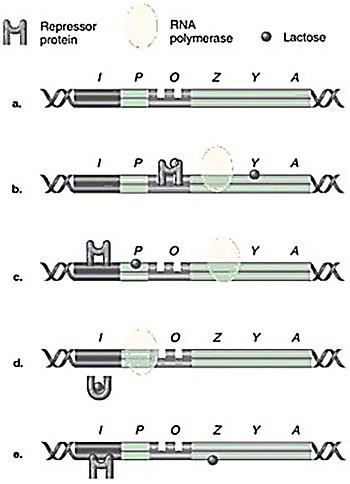
In the figure, which model of the lac operon correctly shows RNA polymerase, lactose, and repressor protein when the structural genes are being transcribed?
a
b
c
d
e
4
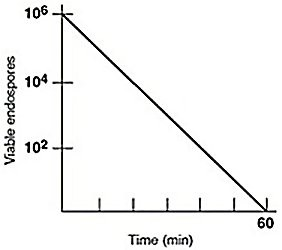
A suspension of 106 Bacillus cereus endospores was put in a hot-air oven at 170°C. Plate counts were used to determine the number of endospores surviving at the time intervals shown.
In the figure, the thermal death point for this culture is
30 minutes.
50°C.
15 minutes.
170°C.
The answer cannot be determined based on the information provided
5
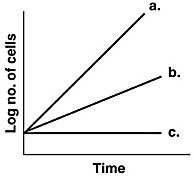
In the figure, which line best depicts a facultative anaerobe in the absence of O2?
a
b
c
2
Which of the following is not an agricultural product made by recombinant DNA technology?
Frost retardant
Pectinase
Glyphosate-resistant crops
Bacillus thuringiensis insecticide
Nitrogenase (nitrogen fixation)
2
Repair of damaged DNA, in some instances and mechanisms, might be viewed as a race between an endonuclease and
DNA ligase.
primase.
methylase.
DNA polymerase.
helicase.
3
One advantage of a viral vector over a plasmid vector is that the
the viral vector can accept larger pieces of DNA and the plasmid vector is circular.
viral vector can harbor a selection marker.
plasmid vector is circular.
viral vector can accept much larger pieces of DNA.
viral vector can accept a PCR fragment.
4
A population of bacterial cells carrying a desired plasmid is called a ________.
library
vector
Southern blot
PCR
clone
5
Which of the following statements is not true regarding a bacterium that is R+?
R+ can be transferred to a different species.
It is F+.
It is resistant to certain drugs and heavy metals.
R+ can be transferred to a cell of the same species.
It possesses a plasmid.
2
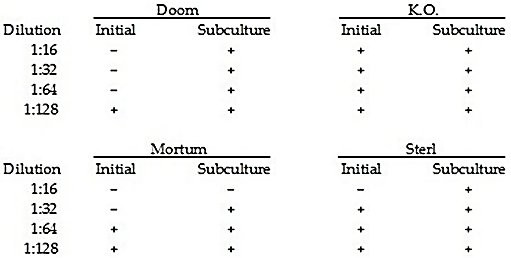
The following data were obtained by incubating gram-positive bacteria in nutrient medium + disinfectant for 24 hours, then transferring one loopful to nutrient medium (subculturing). (+ = growth; - = no growth) (view image)
In the table, which disinfectant was bactericidal?
Doom
K.O.
Mortum
Sterl
The answer cannot be determined based on the information provided.
3
Which of the following could be used to sterilize plastic Petri plates in a plastic wrapper?
gamma radiation
autoclave
ultraviolet radiation
microwaves
sunlight
1
A source of heat-stable DNA polymerase is
Agrobacterium tumefaciens.
Saccharomyces cerevisiae.
Thermus aquaticus.
Pseudomonas.
Bacillus thuringiensis.
3
Which of the following does NOT achieve sterilization?
autoclave
ethylene oxide
dry heat
supercritical fluids
pasteurization
5